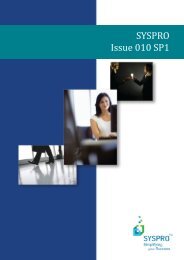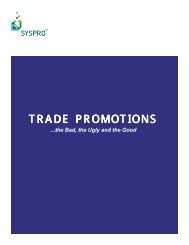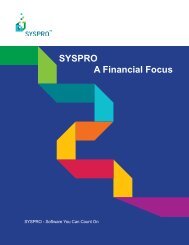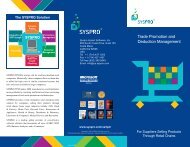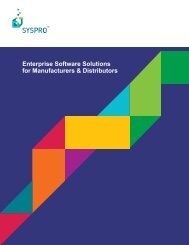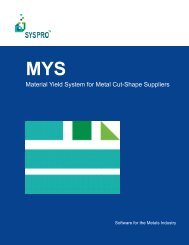Teach Yourself e.net - Syspro
Teach Yourself e.net - Syspro
Teach Yourself e.net - Syspro
Create successful ePaper yourself
Turn your PDF publications into a flip-book with our unique Google optimized e-Paper software.
6<br />
More Advanced Options<br />
Objectives - In this chapter we deal with two concepts that will advance your use of<br />
ASP.NET with e.<strong>net</strong> solutions. We will first tackle XSLT, examining the process of<br />
transforming XML output for use in custom applications and by other proprietary<br />
applications. By the end of this section you will be familiar with XSLT and the<br />
transformation of an XmlOut string to an HTML table. In the second section of this<br />
chapter we will deal with the concept of ASP.NET codebehind, separating the<br />
programming logic from the presentation logic.<br />
If you are already familiar with XSLT and ASP.NET codebehind usage then please move<br />
on to the next chapter.<br />
6.1. Transforming XML<br />
XML is useful for transferring data between applications and between objects within an<br />
application. It is, however, not very useful to present an XML file to an accountant or an<br />
auditor or a data capture clerk. The benefit of using XML as a data transfer standard is that<br />
one can also transform that data into other formats that can then be used to display the<br />
information more effectively.<br />
The transformation standards or capabilities for XML were being developed at the same<br />
time that the XML standard was being developed. Using these standards, it is possible to<br />
transform XML into HTML, SQL scripts, emails, and virtually any other document type.<br />
This happens through the use of XSLT (Extensible Style Language Transformation)<br />
definition files and an XSLT processor.<br />
6.1.1. What is XSLT<br />
XSLT (Extensible Style Language Transformation) is a standard that was created to<br />
transform XML files into other formats or other XML Schemas. An XSL processor reads<br />
the XML document and follows the instructions in the XSL stylesheet, then it outputs the<br />
data as an HTML page, a SQL script, an email, an XML file governed by a different<br />
schema, or any other standardized document type.<br />
XSLT transformations are also useful in situations where the XML document's structure<br />
does not match up well with an application that needs access to the data. An XML<br />
document may contain the appropriate data to be imported into a database, for example,<br />
but may not be structured in the format that the application performing the import expects.<br />
The following two examples show how an XML document can be transformed from one



